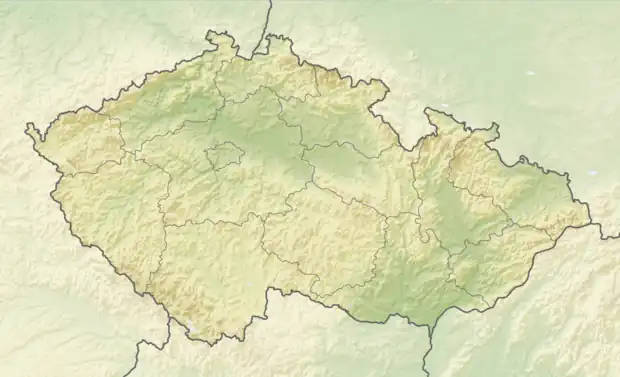Petřvald (Karviná District)
Petřvald (Czech: [ˈpɛtr̝̊valt] ⓘ; Polish: Pietwałd [ˈpjɛtfawt] ⓘ; German: Peterswald) is a town in Karviná District in the Moravian-Silesian Region of the Czech Republic. It has about 7,400 inhabitants.
Petřvald | |
|---|---|
.jpg.webp) Church of Saint Henry | |
_vlajka.jpg.webp) Flag _CoA_CZ.svg.png.webp) Coat of arms | |
 Petřvald Location in the Czech Republic | |
| Coordinates: 49°49′38″N 18°23′9″E | |
| Country | |
| Region | Moravian-Silesian |
| District | Karviná |
| First mentioned | 1305 |
| Government | |
| • Mayor | Jiří Lukša |
| Area | |
| • Total | 12.63 km2 (4.88 sq mi) |
| Elevation | 265 m (869 ft) |
| Population (2023-01-01)[1] | |
| • Total | 7,388 |
| • Density | 580/km2 (1,500/sq mi) |
| Time zone | UTC+1 (CET) |
| • Summer (DST) | UTC+2 (CEST) |
| Postal code | 735 41 |
| Website | www |
Geography
Petřvald is located east of Ostrava, in its immediate vicinity. It lies in the Ostrava Basin lowland in the historical region of Cieszyn Silesia.
History
.JPG.webp)
The creation of the village was a part of a larger settlement campaign taking place in the late 13th century on the territory of what will be later known as Upper Silesia. The settlement was first mentioned in a Latin document of Diocese of Wrocław called Liber fundationis episcopatus Vratislaviensis from 1305 as Petirwalde.[2][3]
Politically the village belonged initially to the Duchy of Teschen, ruled by a local branch of Piast dynasty. In 1327 the duchy became a fee of Kingdom of Bohemia, which after 1526 became part of the Habsburg monarchy.
The village became a seat of a Catholic parish, mentioned in the register of Peter's Pence payment from 1447 among 50 parishes of Teschen deaconry as Petirswalde.[4] After 1540s Protestant Reformation prevailed in the Duchy of Teschen and a local Catholic church was taken over by Lutherans. It was taken from them (as one from around fifty buildings in the region) by a special commission and given back to the Roman Catholic Church on 26 March 1654.[5]
In around 1790, Petřvald was bought by the Larisch-Moennich family, who became its most significant owners and held it until the 20th century. In 1833, coal began to be mined here. Two shafts were opened, both owned by the Larisch-Moennich family. In the second half of the 19th century, additional mines were established. Coal mining has fundamentally affected the development of the municipality.[2]
After World War I, Polish–Czechoslovak War and the division of Cieszyn Silesia in 1920, it became a part of Czechoslovakia. Following the Munich Agreement, in October 1938 together with the Trans-Olza region it was annexed by Poland, administratively organised in Frysztat County of Silesian Voivodeship.[6] It was then annexed by Nazi Germany at the beginning of World War II. After the war it was restored to Czechoslovakia.
In 1955, Petřvald became a town.[7] In 1998, coal mining was definitively stopped.[2]
Demographics
|
|
| ||||||||||||||||||||||||||||||||||||||||||||||||||||||
| Source: Censuses[8][9] | ||||||||||||||||||||||||||||||||||||||||||||||||||||||||
Sights
The most important monument is the Church of Saint Henry. A parish church in Petřvald was first mentioned in 1390. The old wooden church was replaced by a new wooden one in the 18th century. The current brick church was built by Jindřich Larisch-Moennich in 1835–1837. The church complex includes Stations of the Cross.[10]
Notable people
- Vojtěch Mynář (1944–2018), politician
References
- "Population of Municipalities – 1 January 2023". Czech Statistical Office. 2023-05-23.
- "Historie města" (in Czech). Město Petřvald. Retrieved 2022-02-16.
- Panic, Idzi (2015). Śląsk Cieszyński w średniowieczu (do 1528) [Cieszyn Silesia in Middle Ages (until 1528)] (PDF) (in Polish). Cieszyn: Starostwo Powiatowe w Cieszynie. pp. 297–299. ISBN 978-83-935147-8-6.
- "Registrum denarii sancti Petri in archidiaconatu Opoliensi sub anno domini MCCCCXLVII per dominum Nicolaum Wolff decretorum doctorem, archidiaconum Opoliensem, ex commissione reverendi in Christo patris ac domini Conradi episcopi Wratislaviensis, sedis apostolice collectoris, collecti". Zeitschrift des Vereins für Geschichte und Alterthum Schlesiens (in German). Breslau: H. Markgraf. 27: 361–372. 1893. Retrieved 21 July 2014.
- Broda, Jan (1992). "Materiały do dziejów Kościoła ewangelickiego w Księstwie Cieszyńskim i Państwie Pszczyńskim w XVI i XVII wieku". Z historii Kościoła ewangelickiego na Śląsku Cieszyńskim (in Polish). Katowice: Dom Wydawniczy i Księgarski "Didache". pp. 259–260. ISBN 83-85572-00-7.
- "Ustawa z dnia 27 października 1938 r. o podziale administracyjnym i tymczasowej organizacji administracji na obszarze Ziem Odzyskanych Śląska Cieszyńskiego". Dziennik Ustaw Śląskich (in Polish). Katowice. nr 18/1938, poz. 35. 31 October 1938. Retrieved 1 July 2014.
- "Petřvaldské noviny č. 12/2006" (PDF) (in Czech). Město Petřvald. 2006. p. 20. Retrieved 2022-02-16.
- "Historický lexikon obcí České republiky 1869–2011 – Okres Karviná" (in Czech). Czech Statistical Office. 2015-12-21. pp. 3–4.
- "Population Census 2021: Population by sex". Public Database. Czech Statistical Office. 2021-03-27.
- "Historie petřvaldského římskokatolického kostela" (in Czech). Město Petřvald. Retrieved 2022-02-16.
- "Partnerská spolupráce s polskými městy" (in Czech). Město Petřvald. Retrieved 2023-08-04.

